A Brecks Tour today. We started the morning at Lynford with a quick look round the arboretum.
The Nuthatches were piping away and the Goldcrests were singing as we walked down the path. A Green Woodpecker called from away in the trees. We stopped by the gate to have a look at the feeders. There was very little food left on the ground and the main feeders still look empty, but at least the fat balls had been restocked. The cage containing them was coated in tits – mainly Blue Tits and Great Tits. A few Coal Tits dropped down onto the ground to search for any remaining seed there and a Marsh Tit joined them briefly.
There was no sign of any Hawfinches here again, and it looks increasingly like they will not make any meaningful use of these trees this spring. The reasons as to why they have deserted this as a feeding site remain unclear. Consequently, we didn’t hang around here too long but made our way straight down towards the paddocks. This used to be the most regular feeding site for the Hawfinches in previous years, but had fallen out of favour. One or two Hawfinches have now taken to feeding in the paddocks regularly again, so we hoped to catch up with them this morning.
It was the right decision to head straight for the paddocks. As we walked down the hill towards the bridge, a Great Spotted Woodpecker flew over our heads and landed in the trees on the left of the path ahead of us. A second bird flew in behind it had landed in the top of a tree – a Hawfinch. We got it in the scope and had a good look at it, as it perched there. We could hear it calling, a soft, sharp ‘ticking’.
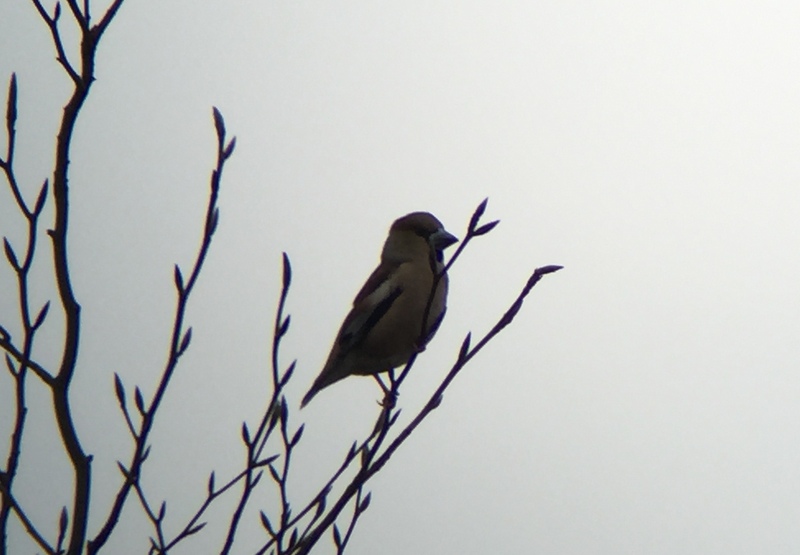 Hawfinch – our first of the day, on the way to the paddocks
Hawfinch – our first of the day, on the way to the paddocks
One of the group had gone to make use of the ‘facilities’ behind us, but still emerged in time to see the Hawfinch through the scope, before it flew on ahead of us. It appeared to be heading for the paddocks, so we made our way swiftly along there. There was another birder there already but he had not seen any sign of it. Presumably it had dropped into the trees without him noticing.
We waited a short while to see if it might fly back up into the trees again, but there was no further sign while we were there. There is no way to see the Hawfinches when they are feeding on the ground here, so it was probably down there already. Still, there were lots of other things to see here. A couple of Song Thrushes were singing from the trees. A Mistle Thrush and a couple of Redwings perched in the tops as well, before dropping down into the grass to feed.
Several Jays flew out of the trees, calling noisily. The Kestrel was on the wires again, showing off for the cameras. It kept dropping down into the grass, but we didn’t see it catch anything while we were there.
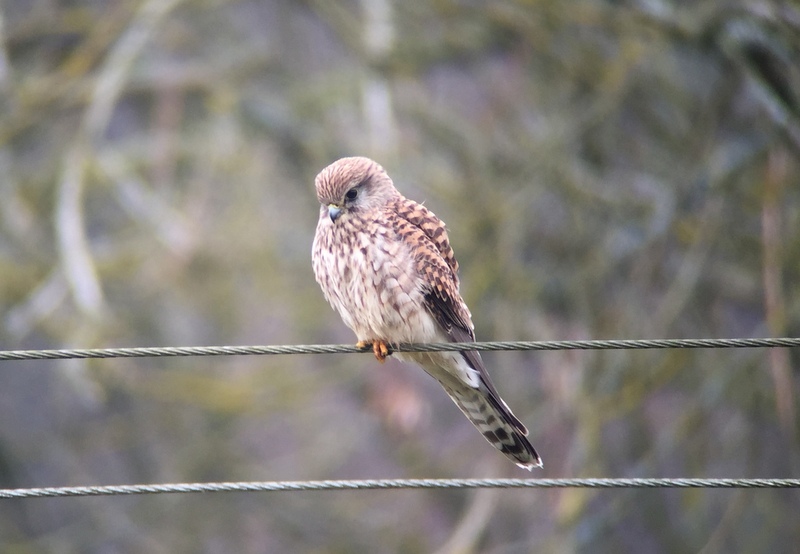 Kestrel – perched on the wires over the paddocks as usual
Kestrel – perched on the wires over the paddocks as usual
We had an appointment deeper in the Forest and with the sun starting to poke through the early morning cloud and a bit of warmth in the air, we decided to move on. A Siskin was singing from the trees by the entrance to the arboretum and we couldn’t resist stopping to listen to it for a few seconds. It appeared on the edge of one of the bare deciduous trees where we could get it in the scope, and watch it singing away, a rapid jumble of trills and twittering. It is the time of year when birds in the Forest are getting down to the business of the breeding season already.
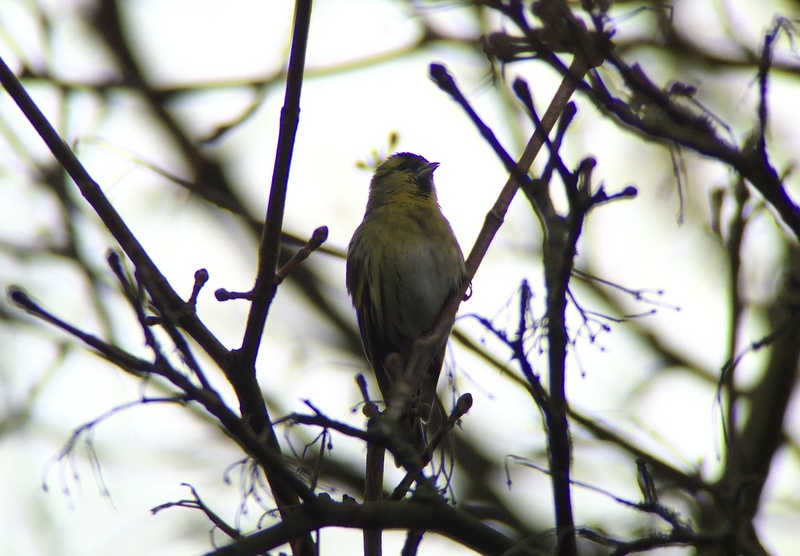 Siskin – singing away at the entrance to the arboretum
Siskin – singing away at the entrance to the arboretum
We drove on deeper into the Forest and parked up at the start of one of the forestry rides. The walk in through the trees was fairly quiet, the dense blocks of commercial pine plantation can be fairly lifeless places at times. A Muntjac walked out onto the track ahead, and looked at us nervously before slipping back into the dense, dark block of trees from which it had just emerged. A few Coal Tits called from the trees along the edge and we heard a Treecreeper as well but couldn’t see it.
We emerged into a large clearing and were immediately greeted by the sound of Woodlarks singing. We could see one perched on a post on the deer fence ahead of us. As we went to get the scope onto it, a second Woodlark appeared on the wire next to it. The two of them perched with crests raised and tails fanned, showing off their white tail tips nicely. The reason soon became clear, when a third Woodlark flew up from the ground below and one of the birds from the fence had a quick tussle with it before it could land on the fence.
 Woodlark – one of several which perched up on the deer fence
Woodlark – one of several which perched up on the deer fence
It soon became clear there were several Woodlarks along the fenceline. Another pair flew in from across the clearing. At one point there seemed to be about six birds in a small area. We decided to walk over for a closer look.
Unfortunately, as we walked round the clearing to the fence, a band of darker cloud came over and any trace of the earlier sunshine was lost. The Woodlarks went quiet and there was no sign of them along the fenceline by the time we got round there. A pair of Stonechats appeared on the fence instead, before disappearing out over the clearing.
We had come here particularly to look for Goshawks, though an early shout of ‘raptor’ over the trees at the back of the clearing produced our first Common Buzzard of the day instead. It was when we looked over that way in response to that call, that we spotted a small pale bird sitting right on the top of a small pine tree. It could only be one thing, the way it was perched there, and a quick look through the scope confirmed we had just found a Great Grey Shrike.
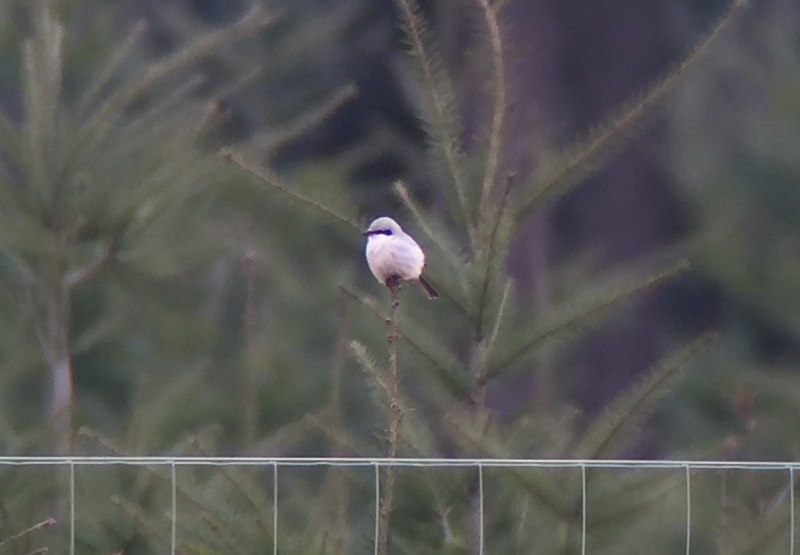 Great Grey Shrike – a ‘new’ bird, deep in the Forest
Great Grey Shrike – a ‘new’ bird, deep in the Forest
Regular readers will know that there has been a very mobile Great Grey Shrike in the area around Grime’s Graves for most of the winter. However, we were a long way from there today, and it seemed highly unlikely that bird would have come all this distance, despite its wandering habits. The question was answered unequivocally when a report came through that the Great Grey Shrike was still present at Grime’s Graves at the same time that we were watching ‘our’ bird. So, we had found another Great Grey Shrike – a real bonus for the day.
Great Grey Shrikes are regular winter visitors to the UK from Scandinavia and further east in rather small numbers. The wintering population in the UK is estimated at just 60 birds, although the number varies from year to year. It is likely that many go undetected and our bird may have been hunting around the deserted clearings deep in the Forest for much of the winter, without being found before.It was a great bird to stumble across like this, and we watched it for some time, mostly perched motionless on the top of the small fir trees, scanning the ground below for suitable prey. Then, as quickly as it had appeared, our Great Grey Shrike slipped away unseen.
With the darker clouds above us, it turned noticeably colder again and there were even some spits of light rain, so the activity of the Common Buzzards tailed off. One of them perched in the top of a tall pine where we could get it in the scope, but the others disappeared into the trees. We waited a while in the hope that a Goshawk might still put in an appearance, but it seemed unlikely that they would be dislpaying now. It seemed like our luck had run dry after the shrike, so we decided to make our way back towards the car.
In typical fashion, the sky had started to brighten up a little just after we had set off. We were half way back when we stopped by a small clearing to wait for a couple of the group to catch up. There is normally a pair of Woodlarks here, so we had just started to scan the area when we noticed a large raptor appear above the trees behind. Silvery grey above and strikingly white below as it turned, it was a big female Goshawk.
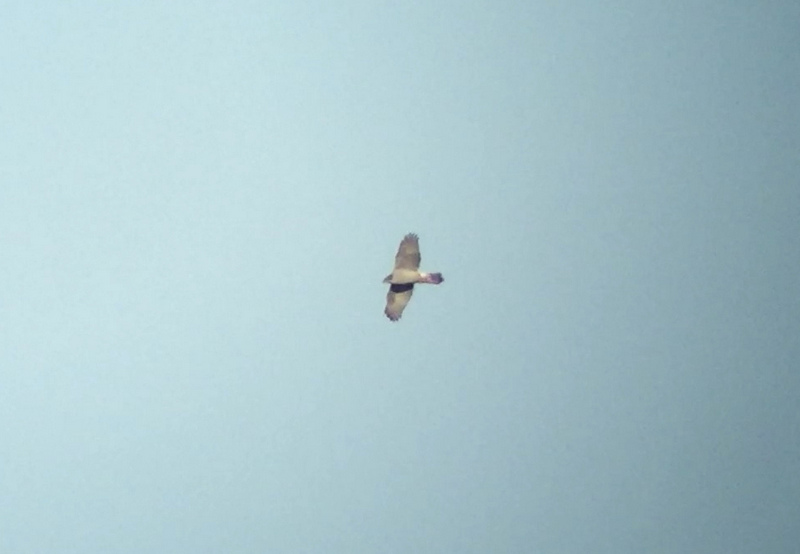 Goshawk – here’s one taken in the same area recently
Goshawk – here’s one taken in the same area recently
We shouted to the others and watched as the Goshawk circled up slowly, before turning and starting a bit of half-hearted display, flying across with exaggerated, deep wingbeats and white undertail coverts puffed out. It disappeared behind the trees again, but we could still see it from time to time between the tops as it headed off in the direction we had just come.
While we were watching the Goshawk disappear, we heard a Yellowhammer singing in the distance and following the sound could see a bright yellow bird perched right in the top of one of the fir trees left standing in the middle of the clearing. The pair of Woodlarks flew across as well and dropped down into the grass.
After an early lunch at Santon Downham, we had a walk up to the churchyard. This is often a good place for Firecrest, though it is still perhaps a little early for them to start singing in earnest. Our attempts to hear them were also thwarted by a steady succession of F-15 aircraft heading in to land at nearby USAF Lakenheath, flying in low over our heads and firing up their engines as they did so – not particularly conducive to hearing the quiet notes of crests in the trees! We did manage to find a couple of Goldcrests flycatching in the tree tops and just about hear a Marsh Tit singing.
Back down at the river bridge, another Marsh Tit perched in a low alder nearby, giving us a great view. We walked downstream along the side of the river in the hope of possibly catching a woodpecker or two, but early afternoon is not the best time to look for them and the best we could manage was a Green Woodpecker which flew across the river. The trees were pretty quiet, apart from several Siskins. A couple of Redpoll flew over calling. A Treecreeper worked its way ahead of us between the trees beside the path.
There was not much activity on the river either today – a couple of Mute Swans and several pairs of Mallard – plus a few noisy Canada and Greylag Geese on the bank the other side. However, the highlight was a Kingfisher which flew ahead of us on the walk out, giving us brief glimpses through the trees as it perched or flew along. On the way back, we did even better and had good views of it through the scope as it perched in the low branches overhanging the edge of the water.
 Kingfisher – along the river at Santon Downham
Kingfisher – along the river at Santon Downham
We finished the afternoon off back at Lynford Arboretum. Again, we headed straight down towards the paddocks, stopping only briefly by the feeders where a family of Long-tailed Tits and a Nuthatch now seemed to have found the refilled fat balls. We didn’t stop long at the bridge either, although with lots of food spread on the wooden posts and brick pillars there were now lots more birds coming down here.
We just had time for a quick look through the trees in the paddocks, where there were still several Song Thrushes. About a dozen Redwings flew in and landed in the tops before dropping down into the grass. Then a scan of the trees beyond revealed a Hawfinch perched right in the tops. It was a bit distant from here, so we walked further along, to where we could get a better view.
 Hawfinch – in the tops of the trees
Hawfinch – in the tops of the trees
Although we were a lot closer from here, the Hawfinch seemed to be interested in something the other side of it and spent most of its time looking the other way. When it finally turned round, we could see it appeared to be a female. While we were looking at it through the scope, a quick scan of the tops revealed another Hawfinch, further back in a gap through the trees. This one was perched side on, a much better view if more distant, and another female.
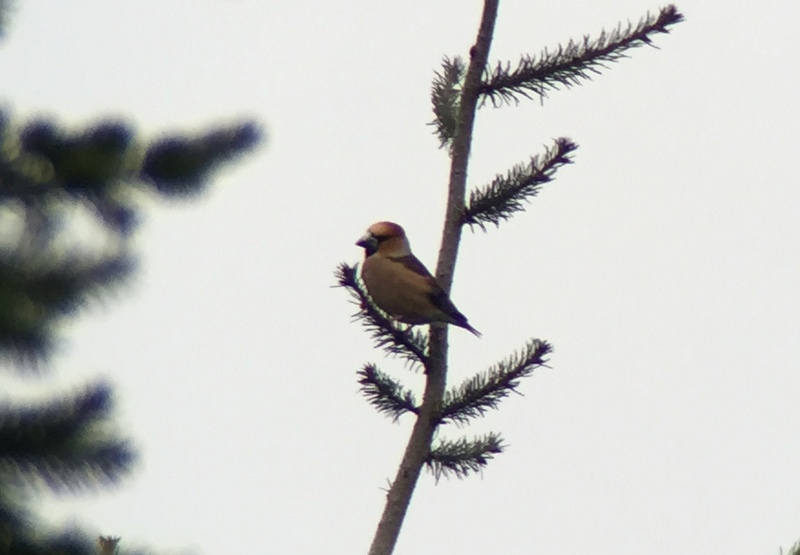 Hawfinch – a brighter male, the female hiding below him in the tree
Hawfinch – a brighter male, the female hiding below him in the tree
We were just lining up to try to get a photo when two more birds flew in and ousted this Hawfinch from its perch. They settled down in the top of the same tree and we could see a male Hawfinch up towards the top and a female lower down in among the branches – presumably a new pair had flown in to join the first two. We had a good look at the male Hawfinch in the scope – noting his brighter colouration, more contrasting black mask and bib and particularly the club-shaped inner primaries.
On the walk back, we stopped by the bridge to look at the birds coming down to the food put out there. We got great views of Marsh Tits coming down to the brick pillars right in front of us, and had a chance to look at the differences from the Coal Tits close up. A Treecreeper flew into the tree beside us and worked its way up several of the trunks in turn before flying off into the wood. A male Reed Bunting appeared on the edge of the trees as well – obviously hoping to take advantage of all the seed put out here.
We walked back to the car park to find we had managed to acquire a puncture, probably just as we drove in – a shard of flint sticking out of the edge of the tyre. The person parked next to us returned a little later and told how they had driven into the car park after us to hear all the air hissing out. Not a perfect way to end, but it had been a really good day in the Brecks with a great selection of the local speciality birds and the added bonus of finding a Great Grey Shrike!
















